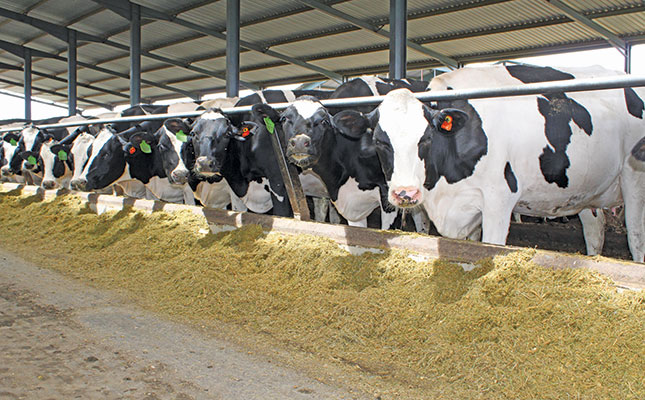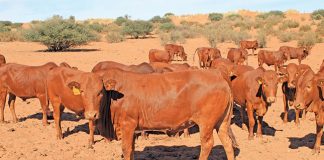
Photo: Lindi Botha
The subject of methane emissions from dairy cattle has received increasing attention from environmental activists concerned about climate change.
This has spilled over to consumers, many of whom are seeking milk alternatives to reduce their carbon footprints.
To maintain market share and increase their sustainability, farmers will thus have to focus on reducing methane emissions to reduce their carbon footprints.
Dr Saheed Salami, research fellow in the solutions deployment team at animal feed and nutrition manufacturer Alltech, notes that the dairy industry is the second-largest source of greenhouse gas (GHG) emissions in the livestock chain.
“It’s very clear that going forward it won’t be business as usual, and stricter environmental regulations will come from governments to reduce emissions. The dairy industry will have to adapt to these changes, while also battling limited resources in terms of land and inputs that we use in milk production.”
Salami explains that crucial to any effort to reduce emissions is the ability to simultaneously increase productivity and profit.
“It doesn’t make any sense if farmers are able to achieve lower GHG emissions, but run at a loss.”
Dairy farmers are already under pressure, considering low milk prices, and with the complexities of reducing methane emissions in their herds, are daunted by the task.
Prof Jude Capper, livestock sustainability consultant, says that in reducing methane emissions, there is no one easy solution; instead, a host of checks and balances need to be put in place on the farm. Fortunately, much of it boils down to better management of cow herds, which would not only increase production, but boost profit too.
“Improving milk yield is the first step in reducing emissions. If you get more milk per cow, it means you need fewer cows to produce the same amount of milk. And removing a cow from the herd automatically reduces the carbon footprint, since water, land, feed and emissions are reduced. This also improves the economics of dairy farming.”
Better nitrogen sources
To understand how emissions can be reduced, it is necessary to identify the source. Salami explains that enteric emissions (those created in the rumen) and the food that cows consume are the two largest sources of emissions on dairy farms, totalling over 60% of total emissions.
The balance is made up of emissions from manure (nitrous oxide), artificial fertiliser, and electricity use. To achieve a more sustainable dairy farm, the farmer needs to focus on all of these factors.
But since emissions from enteric gases and feed make up the largest portion of GHG emissions, this presents the best opportunity for farmers to reduce their carbon footprints. Considering that feed is also one of the biggest expenses on a dairy farm, increasing the efficiency of the feed will bring input costs down, as cows will be able to make do with less.
Salami says that if nitrogen in the feed was better utilised by the cows, the nitrogen excretion causing methane emissions would be reduced.
“Take an example like feed additive Optigen, which is a concentrated source of nitrogen. It allows cattle to release nitrogen into the atmosphere in a controlled form, because the microbial protein is better absorbed in the rumen. Microbial protein represents 50% to 80% of the protein supply that dairy cows need to produce milk, and the more of it they have readily available, the more milk they can produce.”
Feeding cows a more easily absorbed source of nitrogen means they are producing more milk, which improves resource efficiency and reduces the need to have more cows and more feed for the same amount of milk production. Since the nitrogen is absorbed more effectively, the carbon footprint is reduced as methane levels drop.
Reducing need for plant protein
Salami says two decades of research on the effect of more efficient nitrogen-based feed has shown that the need for plant protein sources of feed can be reduced by 23%.
“Specifically, when you look at soya bean meal, which is a common protein source in cows’ diets, adding Optigen reduces the need for feed by about 21%. And we were able to improve energy efficiency by about 3%, which means milk production efficiency increased too.
“Nitrogen utilisation efficiency improved by 4% and, overall, we could see that the nitrogen excretion also reduced by 4%.”
Quantifying these savings in terms of a herd of 1 000 dairy cows, Salami explains that the environmental impact was substantial. “Carbon dioxide emissions were reduced by 647t/ year. That’s equivalent to 1 348 transatlantic flights, or 430 fewer cars on the road.”
He also did an assessment to measure the long-term effects, and the results showed that emissions from better feed alone were reduced by 15% across the life cycle of a cow.
“Clearly, there’s a substantial improvement in milk production efficiency through nutritional strategies, while also improving the carbon footprint of the production.”
Looking at further improvements in nutrition to allow for more milk production per cow, Salami notes the effect of yeast cultures in improving beneficial bacteria activity in the rumen.
“In our research, we looked at the effect that Yea-Sacc, a yeast culture that is able to modify the rumen activity, has on dairy production. A consistent improvement was seen in the growth and activity of fibre-digesting bacteria, which stabilised the rumen pH and led to better digestion. The dairy cow received more nutrients and so was able to increase milk production by about 1kg/cow/day. Nitrogen emissions were also shown to decrease by about 5,4% with better digestion, while the overall carbon footprint was reduced by 3%.”
Quantifying the results across a dairy industry as large as Ireland’s, Salami points out that if the country’s 1,4 million dairy cows were each able to increase milk production by 1kg/ day, it would equate to an increase of almost 434 857t of milk annually. This would mean that 75 200 fewer cows could produce the same amount of milk, resulting in both economic and carbon emission savings.
Animal health also has a big contribution to make in reducing carbon footprints and increasing the profitability of dairy farms. Capper says that globally, 20% of animal protein is lost due to disease. This means that any reduction in disease will ultimately affect yield and carbon footprints.
“If farmers produce less milk due to mastitis, it means they need more cows to make up a certain production target. Increased mortality, a lower weaning rate, failure to conceive and reduced growth rates all mean we need more animals on the farm to produce a certain amount of milk. This equals a greater resource use and higher economic cost.”
Eliminating Johne’s disease in dairy herds would reduce GHG by 24%. Eliminating mastitis would bring a 5% saving, while a reduction in infectious bovine rhinotracheitis (IBR) would result in an 8% saving. Since there are vaccines or management practices that can eliminate all of these issues, the solution is already there.
Capper’s figures show that in the UK, eradicating Johne’s disease through colostrum management could increase profitability by £82/ cow (about R1 600/cow), and decrease GHG emissions by 387t of carbon dioxide during the animal’s lifetime.
IBR mitigation would result in an economic benefit of £95/ cow (R1 900/ cow) and a 277t reduction in carbon dioxide, while eliminating mastitis would increase profitability by £158/ cow (R3 100/ cow) and reduce carbon dioxide emissions by 96t across the cow’s entire life cycle.
Considering that 200t of carbon dioxide is equal to nearly 300 cars on the road, these savings would go a long way towards decreasing the carbon footprint of a dairy farmer. Were carbon taxes to be paid for each ton of carbon, the 387t that a farmer would save through Johne’s disease mitigation would result in a saving of R116 100, considering that the cost of carbon trading on the market is currently R300/t.
Capper further notes that research has shown that while consumers want more environmentally friendly food, they are not prepared to pay extra for it.
“This means farmers need to produce food with a lower carbon footprint, but with no extra economic benefit from the market. We need to work towards improving our systems without it costing us more, because that would not be sustainable.”
Email Prof Jude Capper at [email protected], or Saheed Salami at [email protected].










